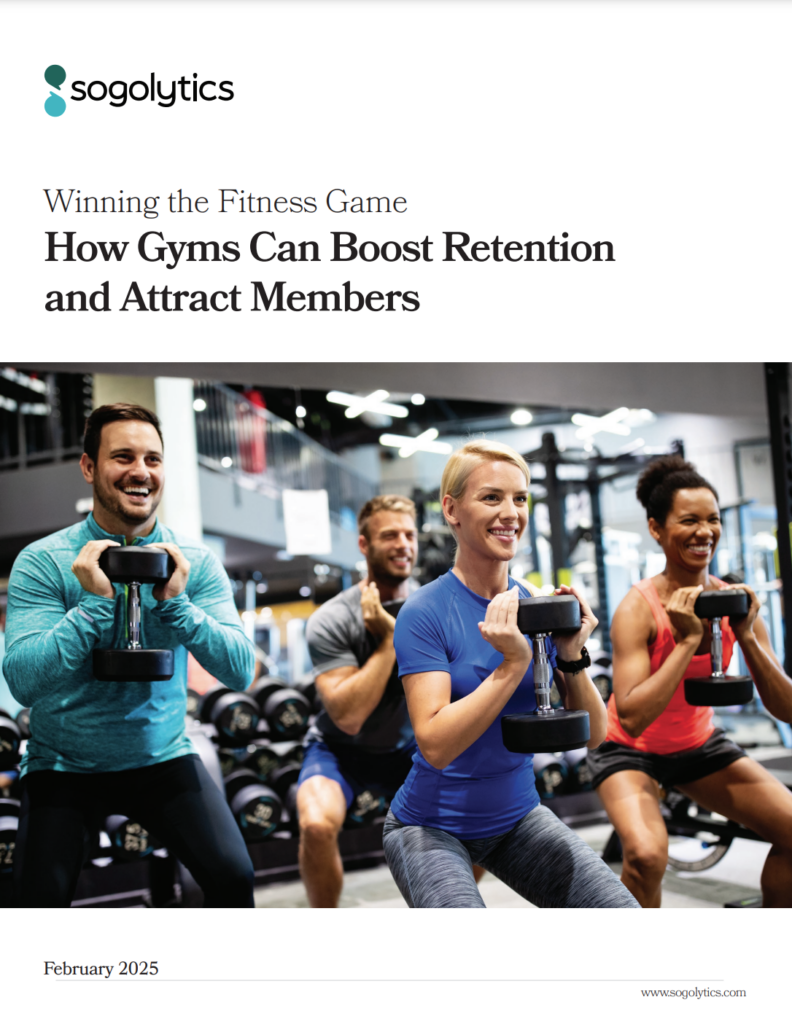Long-term gym membership is the lifeblood of gym success and fitness industry leadership. Simply put, robust gym ROIs depend on retaining members to remedy a nearly 29% annual attrition rate. How problematic is losing twenty-nine seemingly committed members for every one hundred in only 12 months?
The short answer? Very! Consider the following member churn statistics. According to the Health and Fitness Association:
- A lost loyal member leaves an average $674 revenue hole in the P&L, derived from monthly dues and other services, such as personal instruction, group classes, and spa usage
- In contrast, developing a new member to generate the expected loyal member revenue takes years.
- Loyal member churn abruptly ends the gym’s average low sales and marketing cost of around $7.70 per long-term member versus:
- A new member’s average replacement cost (sales and marketing) at $66.74 – nine times higher.
Aside from losing the significantly steady higher revenue stream and relatively low acquisition costs retention generates, the disruption includes the loss of a committed brand ambassador referring friends and family to join the gym’s program (a significant retention contributor in its own right).
Want to learn more about the evolution of the fitness industry and how to drive gym member retention? Explore our full report today!
Seven tips for long-term gym member retention
Tip 1: Offer tiered membership
Launching a gym center-tiered membership is a massive strategic step that you can align with a point-centric loyalty program (see “Tip 2” below) for a two-dimensional perspective. It involves delivering your membership experiences with the top tier offering extraordinary exclusivity, including privileges, discounts, and rewards.
A reflective case study involves a leading gym chain offering Gold and Platinum membership packages. The Gold option defined the lowest denominator. How? It offered high-standard gym facilities as a minimum yardstick, equal standing for Gold members in the training areas, and free but more crowded access to segmented spa additions.
To give you a better vision of how a two-tier system works, the following describes the Platinum package accessible for a higher fee or via privileged loyalty membership (see Tip-2 below):
- Exclusive changerooms with higher-end, private spa facilities, saunas, steam rooms, and 24/7 on-tap beverage refreshments.
- First dibs at:
- Reserving a position in high-demand group sessions.
- Newly introduced training verticals.
- Limited time or member special offers.
- Personal instructor fee discounts.
- Extra towels and complementary toiletry packages.
- Extended entry to other gym branch locations with the same high-end Platinum status.
- Customized virtual access to recorded and live programs when traveling or preferring a home-based workout.
Tip 2: Connect tiered membership options to customer loyalty rewards
Customer reward/loyalty programs have gained traction in marketplaces far and wide with an over 90% US company popularity rate, demonstrating similar retention attractions in the fitness industry. It signals a gym’s efforts to:
- Secure subscriber loyalty, and functions as a competitive incentive for new sign-ups – a two-pronged energizer of gym membership sales.
- Expand the loyal customer category, accounting for around 65% of the gym’s revenue.
- Satisfy the need for a tight community theme, which 29% of gym participants underline vitally supports brand loyalty.
Gym stakeholders should launch a rewards program via earning points for long-term membership (irrespective of the selected level), verified referrals, and patronage of extra payment gym options. Like what, for example? Personal instructors, fee-centric group classes, restaurants, massage therapy, and more.
In short, the better a member’s performance in the above gym verticals, the more points they can earn. The latter serves as valuable currency to upgrade membership (e.g., from Gold to Platinum in our case study above), monetary rebates, fee reductions, and other rewards not included under the selected membership package.
In step with loyalty program thinking, structured referral programs serve as a significant new member magnet, awarding points to gym members for friends, family, and other referrals. For those members focusing on TikTok and Instagram, influencer persuasion can enter gyms with significant discounts or at the highest tiers without paying premium fees.
How do we know referral incentives work in the gym’s favor:
- 60% of marketers across every industry rely on referrals to trigger accelerated lead volume.
- 87% of consumers rate recommendations from friends and family with a firsthand gym experience as the highest on credibility.
- Member referrals convert to new membership 30% more, reflecting a 16% higher member lifecycle value when compared to leads emerging from traditional promotions. In this regard:
- Member referrals are significantly less costly as a lead generator than PPC social media advertising.
- It boils down to your gym customers double-functioning as fee-paying participants and part-time brand ambassadors, saving substantial advertising costs.
- The evidence shows that 50% of gym members respond to referral rewards (as described) or promotion to higher-tier membership as desired recognition.
Tip 3: Leverage gamification
This compelling strategy that creates fun gym workouts to engage members involves leveraging game design versatility. A step in this direction undoubtedly motivates gym-goers, energizes their engagement, and spurs them to accept more ambitious fitness challenges. The net result is more workout fun and growing member loyalty.
A Researchgate Report reflects a direct connection between member engagement and retention rates, led by loyalty initiatives (see above) and consistent gamification challenges that ensure healthy competition and member interaction. Moreover, it’s only half the story, the tip of a gigantic engagement opportunity iceberg.
Consider that gamification strategies show evidence of generating 47% engagement spikes and between 15 and 22% brand loyalty or awareness improvements. Moreover, the massive dual wearable technology and virtual fitness app trends have paved the way for gyms to align their classes and equipment with these devices and the metrics members rely on. The emerging gamification innovations in this channel include:
- Allowing members to set, track, and adjust fitness objectives in real-time with app visuals, alerts, and prompts (effectively robotic instructor guidance.) This inclusion inspires members to increase their gym workout activity and community involvement.
- Offering new challenges and competitions to keep members’ motivation firing on all cylinders. There’s nothing like igniting and sustaining the competitive spirit to do that. What are the best practical methods? Introduce:
-
- Virtual leaderboards aligned with spin classes and other equipment-based sessions.
- Prizes for competition and activity participants, with members accumulating points attached to a hyper-relevant reward menu with:
- The ability to seamlessly use cashable tokens, virtual coins, or progress bars when reaching gym-controlled milestones.
- Access to a reward list that offers partnership-sponsored freebies, free or severely discounted gym merchandise, personal training sessions, or exclusive class permits.
-
- Incentive program designs that cover various activities, including:
- Attending classes consistently.
- Working out for set durations
- Achieving fitness milestones.
- Winning or placing in gym contests.
- Incentive program designs that cover various activities, including:
-
- Group or team challenges (easily adaptable to a B2B model appealing to corporations focusing on employee health):
- The idea is to reward participants working in unison against other units to beat or meet set goals.
- It all occurs in a spirit of friendly competition, community adhesiveness, and accountability to other group members.
- Group or team challenges (easily adaptable to a B2B model appealing to corporations focusing on employee health):
-
TIP 4: Lean toward personalized onboarding
A comprehensive and personalized onboarding sews the loyalty seeds from the get-go, creating a memorable membership experience for recruits. Did you know 87% of members respond to well-thought-out onboarding that boosts engagement, steadying the platform for long-term commitment?
Indeed, this strategy can be a game-changer, propelling you streets ahead of the competition. Why?
- It maximizes gym orientations, fitness assessments, and goal-setting as personalized communication opportunities to establish a sustainable brand image with the onboarding audience.
- Also, it consolidates a sense of purpose and spirit of encouragement that’s likely to endure through the entire member lifecycle.
Here’s some food for thought around the personalized onboarding concept:
- It’s the opposite of a one-size-fits-all approach, emphasizing that new members reflect unique characteristics, requiring customized onboarding experiences.
- Do it right, and reputable stat resources show that it can consolidate an 82% increase in member retention.
- The question is, how do you achieve industry-best standards in your onboarding processes? The four-pronged answer is as follows:
- Your cloud-stored data holds all the solutions. Don’t hesitate to contact expert resource entities like Sogolytics, offering analytic software to unearth member preferences, goals, and fitness level alignments.
- It begins with realistic and manageable goal setting, allowing new members to begin training activities without discouraging results.
- Simultaneously, based on a “baby step” philosophy, your recruits can see progress as they gradually accelerate their regimen intensity.
- Evidence shows that workout schedules that are too repetitive or outside-of-participant-capabilities accelerate demotivation and boredom, triggering discouragement and churn.
Personalized onboarding offers flexibility, adaptability, and variance to keep members engaged via regular assessments and ongoing data analysis.
TIP 5: Offer flexible membership options
We dealt with membership tiering above under Tip 1, but this is something different. Members respond to fee-based flexibility that suits their circumstances. Tiers fall firmly and squarely in that arena, but it goes much further.
The following create a resilient gym retention strategy that matches members’ diverse needs and preferences:
- Various pricing and financing options: Providing different payment terms, point milestone fee reductions, loyalty rewards one can set off against fees, and other innovative configurations make it easier for members to join and fund their long-term commitment to sustained fitness.
- Offer reasonable trial periods: It creates a culture where you’re not pushing people to sign up. On the contrary, it sends a message: “There’s no rush; take your time to make a vital decision about your health.” It puts prospects at ease and smooths entry to a gym where cooperation, support, and innovation speak louder than pressure tactics to produce membership recruitment. Such an approach merges seamlessly with better long-term member retention.
- Easy upgrades, downgrades, pauses, cancellations, and free guest passes: Retention depends on these as staple gym benefits, catering to members’ circumstances changing over time.
- It provides a flexibility level that keeps them engaged, committed, brand loyal, and an enthusiastic contributor to the gym’s community spirit.
- Pauses, in particular, help members financially in cases involving long vacations, job terminations, illness, and more without closing out the membership.
- Membership sign-up agreements with small-print traps dotted everywhere are massive member turn-offs. Make cancellations fair, hassle-free processes that don’t lock members into situations they can no longer fund or align with. Also, never indicate it’s a final goodbye, offering incentivized resigning discounts when the member is ready.
TIP 6: Provide personal training and support
Gyms without this facility are like hamburgers without ketchup. Members expect personalized training and support as a backup if or when needed, stamping it as a winning retention strategy that keeps gym members engaged. Here are my thoughts on this vital benefit:
- By nature and as long as experienced, certified instructors are in the mix, the training is customized, practical, never boring, friendly (i.e., not intimidating), and motivating
- Motivation deserves extra comment. Why? There are up and down days in everyone’s life, and no less when exercising:
- Fitness apps and wearables frequently step in to keep us going when we least feel like it with signals and prompts.
- However, there’s no better motivator than a competent personalized trainer, a primary force behind stakeholders’ strategies to boost member retention.
- Also, remember accountability in fitness training: Knowing there’s a personal instructor in the wings vested in and tracking one’s improvement adds a layer of self-responsibility to the equation.
- Personal training and onboarding frequently go hand-in-hand: Personal trainers usually fulfill roles as super-friendly guides to new members feeling their way into an unfamiliar environment.
TIP 7: Personalize your communications
Newsletters, social media, emails, SMS texts, podcasts, videos (on YouTube), omnichannel devices, and more are in a complex compendium of communication combinations available to gym marketers. Data analytics and feedback provide insights into the voice, tone, and messaging contexts that connect to your members.
Publicize and personalize updates, special offers, workout tips, and success stories instead of generic messages. Communicate as members meet notable milestones in their gym journeys (e.g., birthdays, fitness achievements, referral influence, conquering challenges, and community contributions).
Bonus Tip: Feedback, Surveys, and Continuous Learning
Here’s where Sogolytics enters the picture to ensure you’re feeling the membership temperature at all touchpoints in your participants’ gym experience. The company is at the cutting edge of accumulating crucial feedback via conducting closed- and open-ended surveys to statistically measure member satisfaction enhanced by qualitative data. The availability of AI-powered software can dig into member sentiments and thoughts multiple times faster than an expansive human team.
For example, NPS surveys ask two piercing questions (as follows), speaking volumes for your membership engagement when answered by hundreds of members and collated statistically to reflect groundbreaking insights:
- “How likely are you to recommend our gym to your best friend?” [0 = Not at all Likely / 10 = Extremely Likely]
- “Why did you answer the way you did?”
n other words, keeping a thumb on the pulse of your membership contingent can alert you quickly to disruptive touchpoints and member journeys derailed or about to derail. Other survey formats, like Customer Effort Score or CSAT, are at your fingertips with ready-made templates. When embedded in the data, analytics sorts and evaluates the engagement levels, pinpointing underlying member churn causes. Moreover, when members see their survey suggestions entering the gym program, it reinforces loyalty and lifecycle extension.
If this scenario resonates with you, contact us today for a no-obligation, frank discussion about your gym member retention strategies. You won’t regret it.
FAQs
Q1: Why are personalized communications important for gym stakeholders?
A: Newsletters, social media, emails, SMS texts, podcasts, videos, and omnichannel devices, in collaboration with data analytics and feedback, provide voice, tone, and text messaging that connect meaningfully with your members.
Q2: What are the best feedback surveys to monitor membership engagement?
A: NPS, CSAT, and Customer Effort Score combined with well-placed qualitative questions.
Q3: Are personal trainers functional in member onboarding processes?
A: Personal training and onboarding frequently go hand-in-hand: Personal trainers usually fulfill roles as super-friendly guides to new members feeling their way into an unfamiliar environment.
Q4: What are the price qualities gym members love the most?
A: Different payment terms, points-earned milestone reductions, loyalty rewards one can set off against fees, reasonable trial periods, easy processes for upgrades/downgrades/pauses/cancelations, and free guest passes.















